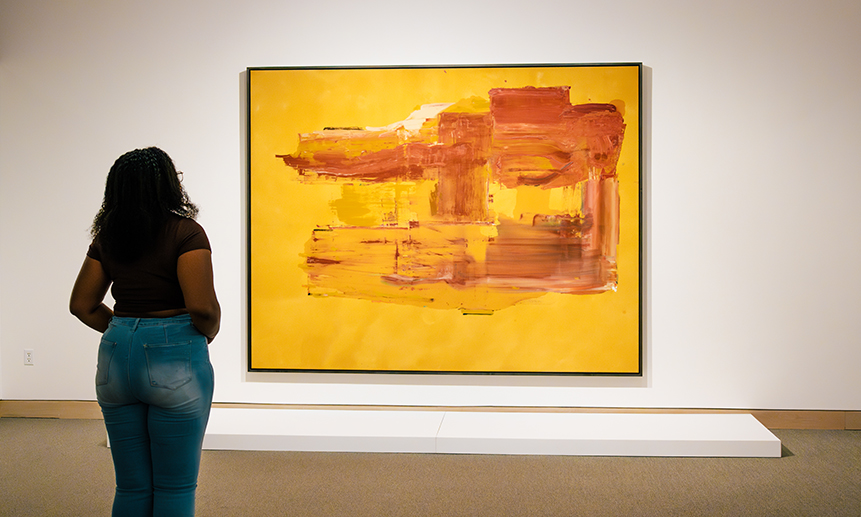
‘Transformative’ gift: Sloans give Frankenthaler painting to Weatherspoon
The Weatherspoon Art Museum’s mission will be bolstered by the work of Helen Frankenthaler, one of the biggest names in 20th-century American painting. Frankenthaler’s “Houdini” (1976), a gift from Linda Fisher Sloan ’82 MFA and Thomas R. Sloan, will be on view at the Weatherspoon beginning June 24.
“This painting lived in our New York apartment for 18 years,” notes Tom Sloan. “We thought that it would make an impact at the Weatherspoon Art Museum, which has been a service to the university, to its students, and to the general population for decades.”
The impact will be profound, says Juliette Bianco, the museum’s Anne and Ben Cone Memorial Endowed Director. “Helen Frankenthaler’s ‘Houdini’ is truly a transformative gift for a museum like the Weatherspoon that prides itself on making exceptional works of art part of a UNC Greensboro education. The museum is a place that not only builds knowledge and empathy but also shares transformative art-centered encounters with students and community members.”
Elizabeth Smith, executive director of the Helen Frankenthaler Foundation, remarks, “The Weatherspoon Art Museum hosted ‘Helen Frankenthaler: Late Works, 1990–2003’ during the summer of 2021. The foundation is delighted to see ‘Houdini’ enter the Weatherspoon’s permanent collection, where it joins ‘Snow Pines,’ a 34-color woodcut from 2004. University-based art museums, with their educational missions, are critical to Frankenthaler’s expanding legacy.”
Through previous giving and by endowing the Sloan Scholarships, which cover tuition and provide support for high-impact learning opportunities, the Sloans have helped many UNCG students reach their educational goals. This generous gift to the museum continues that tradition and reflects the Sloan family’s strong ties to UNCG.
In addition to being an alumna, Linda Sloan is a current UNCG Board of Trustees member, a member of UNCG’s College of Visual and Performing Arts Board of Visitors, and a former adjunct lecturer in the Bryan School of Business and Economics. Tom Sloan served as a member of UNCG’s Board of Trustees for nine years, including a stint as its chair, and has served on the University Investment Fund Board. His mother, Edith V. Sloan ’63, was a graduate of Woman’s College as well as a lecturer in the Department of Mathematics for 17 years.
Frankenthaler’s career spanned six decades and included exhibitions at New York’s Whitney Museum and the Museum of Modern Art, among others. One of the few women to gain prominence in American Abstract Expressionism, her formal and stylistic innovations were key to the development of Color Field painting, an evolution of abstract painting that was considered less gestural and combative than the style typified by Jackson Pollock.
This is not the only work of 20th-century abstract painting that the Weatherspoon owns. “The museum has a major piece from Willem de Kooning that they bought at a very early stage, very cleverly recognizing the importance of that painting,” Sloan says. “I understand ‘Houdini’ will be displayed alongside that work by de Kooning, titled ‘Woman’ (1949).”
This gift comes at a time when the Weatherspoon is taking a fresh look at how its collection can make room for diverse perspectives. “There is an interest now, in particular, in female artists that has accelerated over the last several years,” Sloan adds. Bianco agrees: “We are honored that this remarkable painting, by an innovative and daring woman who challenged people to think differently about paint on canvas, will be studied and enjoyed by UNCG’s students, faculty, and the Greensboro community in perpetuity.”
The first public showing of this gift coincides with the Weatherspoon’s new exhibition, “Making Room: Familiar Art, New Stories,” which engages participants in an inclusive exploration of the diverse stories told through American art that Bianco characterizes as “a major reinstallation of the museum’s collection.” That exhibition is made possible by grants to the museum from the Henry Luce Foundation and the Terra Foundation for American Art.
